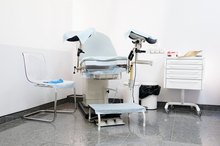What does fact checked mean?
At Healthfully, we strive to deliver objective content that is accurate and up-to-date. Our team periodically reviews articles in order to ensure content quality. The sources cited below consist of evidence from peer-reviewed journals, prominent medical organizations, academic associations, and government data.
- "Obstetrics & Gynecology"; Douching in relation to bacterial vaginosis, lactobacilli, and facultative bacteria in the vagina; Ness, RB, et al. ; October 2002
- "Obstetrics & Gynecology"; Douching in relation to bacterial vaginosis, lactobacilli, and facultative bacteria in the vagina; Ness, RB, et al. ; October 2002
The information contained on this site is for informational purposes only, and should not be used as a substitute for the advice of a professional health care provider. Please check with the appropriate physician regarding health questions and concerns. Although we strive to deliver accurate and up-to-date information, no guarantee to that effect is made.
Causes of Bacterial Vaginosis
Bacterial vaginosis occurs due to an overgrowth of unhealthy anaerobic bacteria and the loss of the healthy bacteria Lactobacillus in the vaginal tract 2. This infection with unhealthy bacteria can only come about when the vagina changes pH from its normally acidic state to alkaline conditions. A rise in the pH of vaginal secretions to over 4.5 typically is seen when bacterial vaginosis is present. Several things can cause this change and lead to a bout of bacterial vaginosis.
If you are experiencing serious medical symptoms, seek emergency treatment immediately.
Sexual Intercourse
Sperm is alkaline, having a high pH value, and when it comes in contact with the normally acidic vagina, it can raise the pH of the vaginal tract, leaving a door open for the overgrowth of anaerobic bacteria. When bacterial vaginosis occurs via sexual transmission, there can be a noticeable alkaline scent after sex. This change in vaginal conditions frequently occurs when intercourse occurs with a new partner, so limiting sexual partners can help prevent bacterial vaginosis caused by sex. Condom use may also help, since it limits the contact between alkaline sperm and the acidic vagina. Treating the male partner for bacterial vaginosis does not have any effect on its recurrence, since the bacterial overgrowth is not a sexually transmitted disease but one caused by an alteration in the normal pH levels of the vagina.
- Sperm is alkaline, having a high pH value, and when it comes in contact with the normally acidic vagina, it can raise the pH of the vaginal tract, leaving a door open for the overgrowth of anaerobic bacteria.
Douching
Acidophilus & Folic Acid for Bacterial Vaginosis
Learn More
Douching alters the natural pH of the vagina, leaving it vulnerable to infection. In a 2002 study in the journal Obstetrics & Gynecology, researchers found that frequent douching of once per month or more raised the risk of developing bacterial vaginosis and also was associated with the growth of two particular microorganisms implicated in the disease, Gardnerella vaginalis and Mycoplasma hominis 2. Women in the study who douched regularly were also found to have less of the healthy lactobacilli in their vaginal tracts.
Menopause
Hormonal changes during menopause can change the naturally acidic vagina to a more alkaline condition. Estrogen is the hormone responsible for maintaining acidity of the vaginal tract, and during menopause, production of estrogen drops off rapidly. Estrogen creams, pills or an estrogen ring inserted into the vagina can help counteract these changes and maintain the normal protective acidity.
Heavy Menstrual Periods
Will Taking Cranberry Tablets Help to Conceive Girl?
Learn More
Women with heavy menstrual periods may find that they develop bacterial vaginosis frequently after experiencing heavy blood flow. This occurs because blood is naturally alkaline, and an abundance of blood in the vaginal tract can alter conditions there enough to promote the development of bacterial vaginosis. Women who recurrently experience this problem may need to get a doctor's prescription for medication to reduce blood flow during the menstrual cycle.
Related Articles
References
- "American Family Physician"; Bacterial Vaginosis: An Update; Barbara Majeroni, MD.; March 1998
- "Obstetrics & Gynecology"; Douching in relation to bacterial vaginosis, lactobacilli, and facultative bacteria in the vagina; Ness, RB, et al. ; October 2002
- Kairys N, Garg M. Bacterial Vaginosis. [Updated 2019 May 4]. In: StatPearls [Internet]. Treasure Island (FL): StatPearls Publishing; 2019 Jan-. Available from: https://www.ncbi.nlm.nih.gov/books/NBK459216/
- Reiter S, Kellogg spadt S. Bacterial vaginosis: a primer for clinicians. Postgrad Med. 2019;131(1):8-18.
- Bilardi J, Walker S, McNair R, et al. Women's Management of Recurrent Bacterial Vaginosis and Experiences of Clinical Care: A Qualitative Study. PLoS One. 2016;11(3):e0151794. Published 2016 Mar 24. doi:10.1371/journal.pone.0151794
- Koumans EH, Sternberg M, Bruce C, et al. The prevalence of bacterial vaginosis in the United States, 2001-2004; associations with symptoms, sexual behaviors, and reproductive health. Sex Transm Dis. 2007;34(11):864-9.
- Kumar N, Behera B, Sagiri SS, Pal K, Ray SS, Roy S. Bacterial vaginosis: Etiology and modalities of treatment-A brief note. J Pharm Bioallied Sci. 2011;3(4):496–503. doi:10.4103/0975-7406.90102
- McDonald HM, Brocklehurst P, Gordon A. Antibiotics for treating bacterial vaginosis in pregnancy. Cochrane Database Syst Rev. 2007;(1):CD000262. Published 2007 Jan 24. doi:10.1002/14651858.CD000262.pub3
- Kairys N, Garg M. Bacterial Vaginosis. [Updated 2019 May 4]. In: StatPearls [Internet]. Treasure Island (FL): StatPearls Publishing; 2019 Jan-.
- Kumar N, Behera B, Sagiri SS, Pal K, Ray SS, Roy S. Bacterial vaginosis: Etiology and modalities of treatment-A brief note. J Pharm Bioallied Sci. 2011;3(4):496–503. doi:10.4103/0975-7406.90102
- Muzny CA, Schwebke JR. Pathogenesis of Bacterial Vaginosis: Discussion of Current Hypotheses. J Infect Dis. 2016;214 Suppl 1(Suppl 1):S1–S5. doi:10.1093/infdis/jiw121
- Mackelprang RD, Scoville CW, Cohen CR, et al. Toll-like receptor gene variants and bacterial vaginosis among HIV-1 infected and uninfected African women. Genes Immun. 2015;16(5):362–365. doi:10.1038/gene.2015.13
- Money D. The laboratory diagnosis of bacterial vaginosis. Can J Infect Dis Med Microbiol. 2005;16(2):77–79. doi:10.1155/2005/230319
- Cook RL, Reid G, Pond DG, Schmitt CA, Sobel JD. Clue cells in bacterial vaginosis: immunofluorescent identification of the adherent gram-negative bacteria as Gardnerella vaginalis. J Infect Dis. 1989;160(3):490-6.
- Bradshaw CS, Sobel JD. Current Treatment of Bacterial Vaginosis-Limitations and Need for Innovation. J Infect Dis. 2016;214 Suppl 1(Suppl 1):S14–S20. doi:10.1093/infdis/jiw159
- Menard JP. Antibacterial treatment of bacterial vaginosis: current and emerging therapies. Int J Womens Health. 2011;3:295–305. doi:10.2147/IJWH.S23814
- Homayouni A, Bastani P, Ziyadi S, et al. Effects of probiotics on the recurrence of bacterial vaginosis: a review. J Low Genit Tract Dis. 2014;18(1):79-86.
- Muzny CA, Schwebke JR. Pathogenesis of Bacterial Vaginosis: Discussion of Current Hypotheses. J Infect Dis. 2016;214 Suppl 1(Suppl 1):S1–S5. doi:10.1093/infdis/jiw121
- Allworth, J. and Peipert, J. Severity of Bacterial Vaginosis and the Risk of Sexually Transmitted Infection.Am J Obstet Gynecol. 2011; 205(2):113.e1-113.e6. doi:10.1016/j.ajog.2011.02.060.
- Bagnall, P. and Rizzolo, D. Bacterial vaginosis: A practical review.J Am Acad Phys Assist. 2017; 30(12):15-21. doi:10.1097/01.JAA.0000526770.60197.fa.
- CDC. Bacterial Vaginosis (BV) Statistics: Bacterial vaginosis is the most common vaginal infection in women ages 15-44. Updated December 17, 2015.
- Centers for Disease Control and Prevention. 2015 Sexually Transmitted Diseases Treatment Guidelines: Bacterial Vaginosis. Atlanta, Georgia; updated June 4, 2015.
- Hainer, B. and Gibson, M. Vaginitis: Diagnosis and Treatment. Am Fam Physician. 2011; 83(7):807-815.
Writer Bio
Bridget Coila specializes in health, nutrition, pregnancy, pet and parenting topics. Her articles have appeared in Oxygen, American Fitness and on various websites. Coila has a Bachelor of Science in cell and molecular biology from the University of Cincinnati and more than 10 years of medical research experience.







